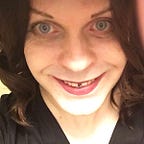My Selection — Bogland
My interpretation of a favorite poem, by Seamus Heaney
Being Irish and a writer/lover of poetry, one of my favorite poets is of course Seamus Heaney. And I spotlight the late master’s piece Bogland here, with its simple, yet precise imagery that evokes the sights, mood and even textures of Irish bog land (elsewhere known as marshland, or wetland). The opening stanzas quickly paint a wide open landscape, near sunset:
We have no prairies
To slice a big sun at evening –
Everywhere the eye concedes to
Encroaching horizon,Is wooed into the cyclops’ eye
Of a tarn. Our unfenced country
Is bog that keeps crusting
Between the sights of the sun.
The two stanzas veer from warm words (prairies, sun) to cool ones (bog, tarn), and this contrast rings true for bog land itself; as peat turf comes from these naturally wet places, and yet it’s used as a traditional heat source. While cyclops’ eye is used as metaphor here (a tarn being a pool, or small lake within bog land), for me, the term also invokes further myth; as in the Irish god Balor — whose single terrible eye destroys all.
Interestingly, the word ‘bog’ itself means god in Slavic (for example, the dark god Chernabog), and is also part of the word boggart; a type of nasty fairy that dwells in marshes, wetlands, and indeed, bogs. These first two stanzas also contain imagery of eyes piercing eyes (the narrator's eyes meeting the tarn ‘eye’), or suggest eyes being pierced in general (into the cyclops’ eye); like the unfortunate cyclops Polyphemus (blinded by the devious Odysseus), or poor Balor; blinded by that other Irish deity, Lugh.
Lugh is also suggested to me by the repeated sun imagery (and more eye imagery, with the word sights), this god of light, again, being the one who destroys dark Balor. Indeed, I can easily imagine that great battle, between the Tuatha Dé Dannan and the monstrous Fomorians, taking place on the widescreen setting of bog land. With all those slain being slowly consumed into earth, and later fossilized; like the once real creature in the next stanza.
They’ve taken the skeleton
Of the Great Irish Elk
Out of the peat, set it up
An astounding crate full of air.
The Irish Elk was a giant species of deer that once roamed prehistoric Ireland (and Europe); the animal standing about six to nine feet tall, with antlers spanning twelve feet at most. The Elk was hunted to extinction here and elsewhere (by early human settlers), and its bones have been found in bogs around Ireland; with some magnificent skeletons now on display in Dublin’s Natural History Museum (aka The Dead Zoo). Some ancient, if more preserved human remains have been also found in bogs, and these bog bodies are covered in other Heaney poems (like Tolland Man).
The final four stanzas of Bogland flow together as one:
Butter sunk under
More than a hundred years
Was recovered salty and white.
The ground itself is kind, black butterMelting and opening underfoot,
Missing its last definition
By millions of years.
They’ll never dig coal here,Only the waterlogged trunks
Of great firs, soft as pulp.
Our pioneers keep striking
Inwards and downwards,Every layer they strip
Seems camped on before.
The bogholes might be Atlantic seepage.
The wet centre is bottomless.
A textural sandwich is achieved in these stacked stanzas; with the black and indeed butter-like bog peat that sinks beneath one’s feet, a literal and waxy butter recovered from the ground (an ancient way of preserving milk fat butter), and the water-pulped wood of dead trees that once grew on the bog— all captured here by Heaney, in his limited, but precise word usage.
The use of seepage and wet centre in the final lines re-enforces the damp, squelchy feel of a bog, and highlights the treacherous bog holes; well-like pits in the ground, that are filled with water, muck and rotted vegetation, and are perhaps truly bottomless . . . a danger to any poor soul that falls into one (and tragically, this can happen). The poem’s last line also recalls imagery of a hole, circle or center; the sun, an eye, a pool of water, or in this last case, a bog hole. And again, while Seamus Heaney uses bogs as fuel for other poems, Bogland is my own personal favorite. For this poem is especially sparse, yet also richly tactile and layered; like a real bog.
